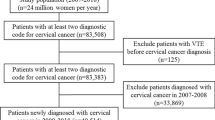Abstract
Purpose
Studies published so far have focused on gynecologic cancer and reported that adenocarcinoma cell type and late-stage are prognostic factors for venous thromboembolism (VTE), particularly in ovarian and endometrial cancers. However, the association between VTE and cervical cancer remains unclear. This study aimed to investigate the incidence of and risk factors for VTE in patients with cervical cancer.
Methods
In this retrospective case–control study, we investigated cervical cancer patients diagnosed from 2011 to 2013 in our hospital. All medical records were comprehensively reviewed to identify VTE cases; these were included in the case group. The control group was sampled by age–group matching. The case-to-control ratio was 1:3. The data were analyzed via conditional logistic regression to identify risk factors for VTE.
Results
The overall incidence of VTE was 8.2% (76/926). Approximately 89% of VTE cases involved deep vein thrombosis. Twenty-one out of 76 VTE patients were diagnosed during pre-treatment. The initial incidence of VTE during cancer diagnosis was 2.27% (21/926). Independent risk factors for overall VTE were adenocarcinoma cell type (odds ratio [OR] 1.99; 95% confidence interval [CI] 1.02, 3.89) and hydronephrosis (OR 2.204, 95% CI 1.03–4.72).
Conclusion
The initial incidence of VTE in cervical cancer patients was 2.27%. Additionally, adenocarcinoma cell type and hydronephrosis were specific risk factors for VTE events in patients with cervical cancer. Our findings suggest that VTE should be monitored by symptoms and physical examination in patients with cervical cancer who initially have hydronephrosis or adenocarcinoma cell type.


Similar content being viewed by others
References
Khorana AA. Venous thromboembolism and prognosis in cancer. Thromb Res. 2010;125:490–3. https://doi.org/10.1016/j.thromres.2009.12.023.
Virchow RLK. Thrombosis and emboli. Canton: Science History Publications; 1998.
Caprini JA. Thrombosis risk assessment as a guide to quality patient care. Dis Mon. 2005;51:70–8. https://doi.org/10.1016/j.disamonth.2005.02.003.
Caprini JA. Individual risk assessment is the best strategy for thromboembolic prophylaxis. Dis Mon. 2010;56:552–9. https://doi.org/10.1016/j.disamonth.2010.06.007.
Rogers SO Jr, Kilaru RK, Hosokawa P, Henderson WG, Zinner MJ, Khuri SF. Multivariable predictors of postoperative venous thromboembolic events after general and vascular surgery: results from the patient safety in surgery study. J Am Coll Surg. 2007;204:1211–21. https://doi.org/10.1016/j.jamcollsurg.2007.02.072.
Graul A, Latif N, Zhang X, Dean LT, Morgan M, Giuntoli R, et al. Incidence of venous thromboembolism by type of gynecologic malignancy and surgical modality in the national surgical quality improvement program. Int J Gynecol Cancer. 2017;27:581–7. https://doi.org/10.1097/IGC.0000000000000912.
Ye S, Yang J, Cao D, Bai H, Huang H, Wu M, et al. Characteristic and prognostic implication of venous thromboembolism in ovarian clear cell carcinoma: a 12-year retrospective study. PLoS ONE. 2015;10:e0121818. https://doi.org/10.1371/journal.pone.0121818.
Ye S, Zhang W, Yang J, Cao D, Huang H, Wu M, et al. Pattern of venous thromboembolism occurrence in gynecologic malignancy: incidence, timing, and distribution a 10-year retrospective single-institutional study. Medicine (Baltimore). 2015;94:e2316. https://doi.org/10.1097/MD.0000000000002316.
Natphopsuk S, Settheetham-Ishida W, Pientong C, Sinawat S, Yuenyao P, Ishida T, Settheetham D. Human papillomavirus genotypes and cervical cancer in northeast Thailand. Asian Pac J Cancer Prev. 2013;14:6961–4. https://doi.org/10.7314/apjcp.2013.14.11.6961.
Tsai SJ, Ruan YX, Lee CC, Lee MS, Chiou WY, Lin HY, et al. The incidence of venous thromboembolism in cervical cancer: a nationwide population-based study. BMC Res Notes. 2012;21(5):316. https://doi.org/10.1186/1756-0500-5-316.
Abu Saadeh F, Norris L, O’Toole S, Gleeson N. Venous thromboembolism in ovarian cancer: incidence, risk factors and impact on survival. Eur J Obstet Gynecol Reprod Biol. 2013;170:214–8. https://doi.org/10.1016/j.ejogrb.2013.06.004.
Machida H, Hom MS, Maeda M, Yeo JJ, Ghattas CS, Grubbs BH, et al. Signs and symptoms of venous thromboembolism and survival outcome of endometrial cancer. Int J Gynecol Cancer. 2016;26:924–32. https://doi.org/10.1097/IGC.0000000000000684.
Barbera L, Thomas G. Venous thromboembolism in cervical cancer. Lancet Oncol. 2008;9:54–60. https://doi.org/10.1016/S1470-2045(07)70409-6.
Matsuo K, Moeini A, Machida H, Fullerton ME, Shabalova A, Brunette LL, et al. Significance of venous thromboembolism in women with cervical cancer. Gynecol Oncol. 2016;142:405–12. https://doi.org/10.1016/j.ygyno.2016.06.012.
Varki A. Trousseau’s syndrome: multiple definitions and multiple mechanisms. Blood. 2007;110:1723–9. https://doi.org/10.1182/blood-2006-10-053736.
Satoh T, Matsumoto K, Tanaka YO, Akiyama A, Nakao S, Sakurai M, et al. Incidence of venous thromboembolism before treatment in cervical cancer and the impact of management on venous thromboembolism after commencement of treatment. Thromb Res. 2013;131(4):e127–32. https://doi.org/10.1016/j.thromres.2013.01.027.
Walker AJ, Baldwin DR, Card TR, Powell HA, Hubbard RB, Grainge MJ. Risk of venous thromboembolism in people with lung cancer: a cohort study using linked UK healthcare data. Br J Cancer. 2016;115:115–21. https://doi.org/10.1038/bjc.2016.143.
Blom JW, Osanto S, Rosendaal FR. The risk of a venous thrombotic event in lung cancer patients: higher risk for adenocarcinoma than squamous cell carcinoma. J Thromb Haemost. 2004;2:1760–5. https://doi.org/10.1111/j.1538-7836.2004.00928.x.
Gomes M, Khorana AA. Risk assessment for thrombosis in cancer. Semin Thromb Hemost. 2014;40:319–24. https://doi.org/10.1055/s-0034-1370770.
Wattanakit K, Cushman M. Chronic kidney disease and venous thromboembolism: epidemiology and mechanisms. Curr Opin Pulm Med. 2009;15:408–12. https://doi.org/10.1097/MCP.0b013e32832ee371.
Zoccali C, Mallamaci F. Pulmonary embolism in chronic kidney disease: a lethal, overlooked and research orphan disease. J Thromb Haemost. 2012;10:2481–3. https://doi.org/10.1111/jth.12046.
Morgan MA, Iyengar TD, Napiorkowski BE, Rubin SC, Mikuta JJ. The clinical course of deep vein thrombosis in patients with gynecologic cancer. Gynecol Oncol. 2002;84(1):67–71. https://doi.org/10.1006/gyno.2001.6452.
Bhatla N, Aoki D, Sharma DN, Sankaranarayanan R. Cancer of the cervix uteri. Int J Gynaecol Obstet. 2018;143(Suppl 2):22–36. https://doi.org/10.1002/ijgo.12611.
Funding
This study was funded by the Faculty of Medicine, Prince of Songkla University, Songkhla, Thailand.
Author information
Authors and Affiliations
Corresponding author
Ethics declarations
Conflict of interest
The authors have no relevant financial or non-financial interests to disclose.
Additional information
Publisher's Note
Springer Nature remains neutral with regard to jurisdictional claims in published maps and institutional affiliations.
Rights and permissions
Springer Nature or its licensor (e.g. a society or other partner) holds exclusive rights to this article under a publishing agreement with the author(s) or other rightsholder(s); author self-archiving of the accepted manuscript version of this article is solely governed by the terms of such publishing agreement and applicable law.
About this article
Cite this article
Kornsilp, S., Pichatechaiyoot, A. Risk Factors for Venous Thromboembolism in Cervical Cancer: A Retrospective Case–Control Study in Southern Thailand. Indian J Gynecol Oncolog 21, 23 (2023). https://doi.org/10.1007/s40944-022-00695-0
Received:
Revised:
Accepted:
Published:
DOI: https://doi.org/10.1007/s40944-022-00695-0




